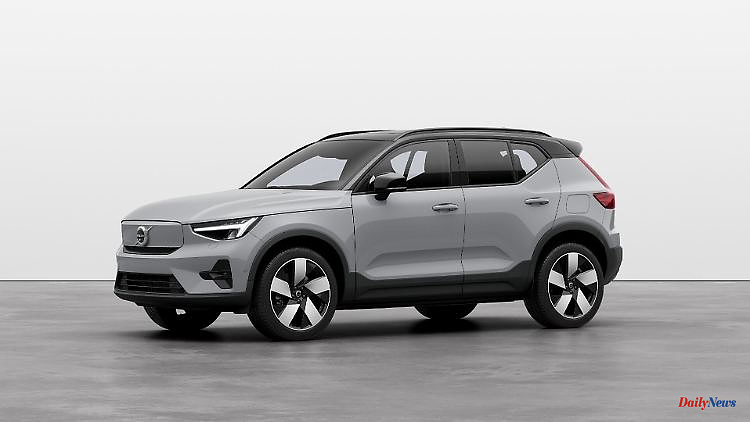Before Volvo goes fully electric in a few years, customers still have the choice of driving a petrol engine, while diesel is passé in the compact class. ntv.de is testing the XC40 B4 and is also providing the electrical output.
Strictly speaking, even the XC40 B4 no longer drives purely with a petrol engine. Mildly hybridized is better - a small electric motor with 14 hp and 40 Newton meters of torque boosts the crankshaft to support the petrol engine, especially in the lower speed range. You can tell that it has this function by looking at the pedal feel of the brakes. It is extremely easy to operate because it works "by-wire". So no more use of physical strength, there is only a pedal pressure simulator. And braking is often done via recuperation, the friction brake only comes into play when the deceleration is stronger. Protects against excessive brake pad wear and recovers braking energy. If that's not a win-win situation.
After all, the pedal feel fits the rest of the character of the XC40 B4. The compact SUV should be comfortable and easy to operate. Driving challenges would only be a nuisance. Of course, the steering should provide a small portion of road contact and pull the Swede reasonably precisely around bends, but that's what it does. And even a functional car should have an active heart under the bonnet, which in this case is stylishly designed. Therefore, the B4 is a nice compromise between efficiency and the associated tolerable maintenance costs as well as decent performance. With 197 hp you are not obscenely strong, but you are not weak either.
In addition, the lower middle class does not overtax its front tires with this machine - so you can do without all-wheel drive at least in moderate weather conditions. However, when using the full power, it is quite lively forward, the work calls 7.4 seconds for the sprint to 100 km/h. The two-liter four-cylinder revs up lightly and confidently and not blaring excessively. For the average WLTP discipline, Volvo calls 6.6 to 7.3 liters of premium petrol per 100 kilometers - so potential customers can get an idea of what to expect at the gas station.
Then it goes into the battery-electric version. For a change, the large variant is available with two engines and a full 408 hp system output. Volvo does its job, offers the full indulgence aroma even in the compact forty if desired, in case fans of the combustion engine need a little nudge to win them over to the switch. However, the Stromer generally start with more powerful engine power, namely with at least 238 hp - but then the battery is smaller, stores only 69 kWh of electricity, so rather uncomfortable for drivers who are afraid of range. With 47,500 euros for the electrically powered base, you rank at the level of the comparison partner B4 (46,600 euros), but the Stromer is even cheaper because a total of 6750 euros subsidy can be deducted.
The 252 hp version with a starting price of 53,000 euros (without subsidy) and a large 82 kWh battery would be best comparable in price to the B4, but was not yet available at the time of this writing. And another argument for the bearish twin engine: With a combined WLTP power consumption of 17.8 to 18.7 kWh/100 kilometers, the top model is barely below the base (17.1 to 18 kWh). So roam fast without regrets? At least the temptation is great and if the budget is right, the fast Swede is in the running. However, 59,950 euros are still quite a bite despite the 4500 euros environmental deduction.
In any case, a test drive could confirm this development, because the all-wheel drive really gets off to a flying start. After 4.9 seconds, 100 km/h are on the agenda, but the powertrain cannot be reduced to sheer numbers. The way in which intermediate sprints are completed is of course unusual for such a compact SUV. While the otherwise smoothly acting seven-speed double clutch is still looking for the right gear ratio, the BEV simply storms off. But one man's joy is another man's sorrow, you know.
If you don't have a stable stomach, you can get pretty bummed with full use of the power, depending on the steering angle. In any case, you don't need more than 400 hp to be driven confidently. The fun factor is still a difficult argument to invalidate if you like performance. She usually keeps the corners of her mouth up. Volvo should think again about the setting to do without a range display. So there is only the battery charge level in percent, only from 50 kilometers down does the on-board computer also show the remaining distance on the generously available TFT surface. That makes it difficult to plan longer distances because you want to know how far you can go, for example to reach the next loader.
Otherwise it can be said that the Stromer, which is almost 500 kilograms heavier (than the petrol engine), has more binding springs and thus makes the impression of the more comfortable variant. Incidentally, this wrap goes well with the fluffy upholstered furniture. Lateral dynamic skills generally only play a subordinate role with the XC40, because the demands on the segment in this regard are not particularly high. Nevertheless, clever packaging of the batteries ensures a favorable center of gravity, so that the heavy-weight Volvo is by no means phlegmatic about the winding country road.
The question remains: which one to take? To be honest, the Stromer is more fun, but that's because the B4's four-cylinder engine isn't an incredibly emotional engine. On the other hand: If you really often cover a lot of distance, you have to consider that charging even with more than 150 kW peak power (the XC40 doesn’t last long) simply takes longer than conventional refuelling.
The 27 minutes specified by Volvo for a charge from 10 to 80 percent on the at least 200 kW DC charger do not always prove to be reliable in practice (but not as far-fetched either, sometimes it works). And even the standard heat pump only helps to a limited extent against temperature-related range fluctuations.
It is a good idea to simply bridge the loading time by working on your mobile phone or computer. Eating would be the other option. This is how you slowly but surely get into everyday life with electromobility. However, loading times will continue to decrease. And until then, even at Volvo, you still have the choice of buying the petrol engine.












